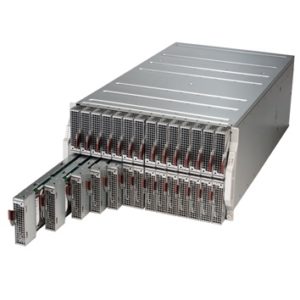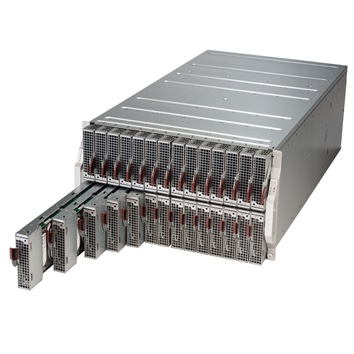 Today Supermicro announced deployment of its disaggregated MicroBlade systems at one of the world’s highest density and energy efficient data centers.
Today Supermicro announced deployment of its disaggregated MicroBlade systems at one of the world’s highest density and energy efficient data centers.
A technology-leading Fortune 100 company has deployed over 30,000 Supermicro MicroBlade servers, at its Silicon Valley data center facility with a Power Use Effectiveness (PUE) of 1.06, to support the company’s growing compute needs. Compared to a traditional data center running at 1.49 PUE, or more, the new datacenter achieves an 88percent improvement in overall energy efficiency. When the build out is complete at a 35 megawatt IT load power, the company is targeting $13.18M in savings per year in total energy costs across the entire datacenter.
The Supermicro MicroBlade system represents an entirely new type of computing platform. It is a powerful and flexible extreme-density 3U or 6U all-in-one total system that features 14 or 28 hot-swappable MicroBlade Server blades. The system deliver 86% improvement in power/cooling efficiency with common shared infrastructure, 56 percent system density improvement and lower initial investment versus 1U servers. The solution has 280 Intel Xeon processor-servers per rack and achieves 45 percent to-65 percent CAPEX savings per refresh cycle with a dissagregated rack scale design.
“With 280 Intel Xeon processor-servers in a 9-foot rack, and up to 86 percent improvement in system cooling efficiency, the MicroBlade system is a game changer,” said Charles Liang, President and CEO of Supermicro. “Leveraging our Silicon Valley based engineering team and global service capabilities, Supermicro collaborated closely with the company’s IT department and delivered a solution from design concept to optimally tuned, high-quality product with full supply chain and large-scale delivery support in five weeks. With our new MicroBlade and SuperBlade, we have changed the game of blade architecture to make blades the lowest in initial acquisition cost for our customers, not just the best in terms of computation, power efficiency, cable-less design, and TCO.”
The Supermicro MicroBlade disaggregated architecture unlocks the interdependence between the major server subsystems enabling the independent upgrade of CPU+Memory, I/O, Storage and, Power/Cooling. Now each component can be refreshed on-time to maximize Moore’s Law improvements in performance and efficiency versus waiting for a single monolithic server refresh cycle.
A disaggregated server architecture enables the independent upgrades of the compute modules without replacing the rest of the enclosure including networking, storage, fans and power supplies, which refresh at a slower rate,” said Shesha Krishnapura, Intel Fellow and Intel IT CTO. “By disaggregating CPU and memory, each resource can be refreshed independently allowing data centers to reduce refresh cycle costs. When viewed over a three to five year refresh cycle, an Intel Rack Scale Design disaggregated server architecture will deliver, on-average, higher-performing and more-efficient servers at lower costs than traditional rip-and-replace models by allowing data centers to independently optimize adoption of new and improved technologies.”
The MicroBlade provides the perfect building block for a Rack-Scale design data center solution. The networking across all server blades is aggregated into just two ports for uplink through an integrated switch, eliminating the need for Top-of-Rack (ToR) switches and complex cabling. With up to 99% cabling reduction for the MicroBlade system, airflow is significantly improved, which in turn reduces the load on the cooling fans, resulting in even lower OPEX. Up to 86 percent cooling fan power efficiency improvement is achieved by sharing four cooling fans and integrated power modules across all 14 MicroBlade server blades. The MicroBlade enclosure is configured with a Chassis Management Module for unified management and redundant 2,000 watt Titanium Level certified digital power supplies for 96% energy efficiency. Supermicro MicroBlade is shipped with industry standard IPMI 2.0 and Redfish API designed to lower management overhead in large scale data centers. The MicroBlade also supports DP Intel Xeon E5-2600 v4/v3 processors (MBI-6128R-T2/T2X blade server part numbers).
In addition to the MicroBlade, Supermicro is introducing a new SuperBlade architecture with more deployment options. The X10 Generation SuperBlade supports up to 10/14/20 ES-2600 v4 dual processor nodes per 7U chassis with many of the same features as the MicroBlade system. The new 8U SuperBlade systems use the same Ethernet switches, chassis management modules, and software as the MicroBlade for improved reliability, serviceability, and affordability. The systems are designed to support DP and MP processors up to 205 watts in half-height and full-height blades, respectively. Similarly, the new 4U SuperBlade systems maximize performance and efficiency while enabling up to 140 dual-processor servers or 280 single-processor servers per 42U rack.




